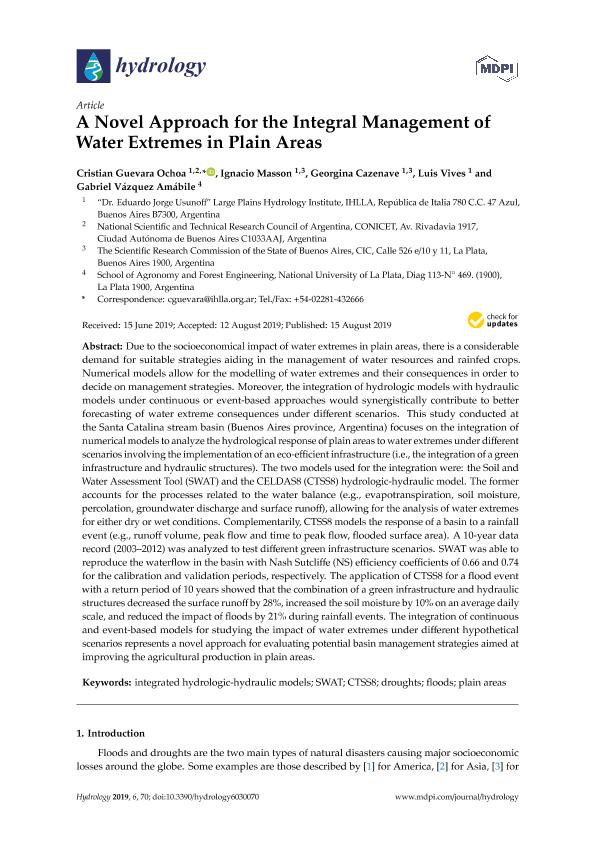Artículo
A Novel Approach for the Integral Management of Water Extremes in Plain Areas
Guevara Ochoa, Cristian ; Masson, Ignacio; Cazenave, Georgina
; Masson, Ignacio; Cazenave, Georgina ; Vives, Luis Sebastián; Vazquez Amabile, Gabriel Gustavo
; Vives, Luis Sebastián; Vazquez Amabile, Gabriel Gustavo
 ; Masson, Ignacio; Cazenave, Georgina
; Masson, Ignacio; Cazenave, Georgina ; Vives, Luis Sebastián; Vazquez Amabile, Gabriel Gustavo
; Vives, Luis Sebastián; Vazquez Amabile, Gabriel Gustavo
Fecha de publicación:
15/08/2019
Editorial:
MDPI
Revista:
Hydrology
ISSN:
2306-5338
Idioma:
Inglés
Tipo de recurso:
Artículo publicado
Clasificación temática:
Resumen
Due to the socioeconomical impact of water extremes in plain areas, there is a considerable demand for suitable strategies aiding in the management of water resources and rainfed crops. Numerical models allow for the modelling of water extremes and their consequences in order to decide on management strategies. Moreover, the integration of hydrologic models with hydraulic models under continuous or event-based approaches would synergistically contribute to better forecasting of water extreme consequences under different scenarios. This study conducted at the Santa Catalina stream basin (Buenos Aires province, Argentina) focuses on the integration of numerical models to analyze the hydrological response of plain areas to water extremes under different scenarios involving the implementation of an eco-efficient infrastructure (i.e., the integration of a green infrastructure and hydraulic structures). The two models used for the integration were: the Soil and Water Assessment Tool (SWAT) and the CELDAS8 (CTSS8) hydrologic-hydraulic model. The former accounts for the processes related to the water balance (e.g., evapotranspiration, soil moisture, percolation, groundwater discharge and surface runoff), allowing for the analysis of water extremes for either dry or wet conditions. Complementarily, CTSS8 models the response of a basin to a rainfall event (e.g., runoff volume, peak flow and time to peak flow, flooded surface area). A 10-year data record (2003?2012) was analyzed to test different green infrastructure scenarios. SWAT was able to reproduce the waterflow in the basin with Nash Sutcliffe (NS) efficiency coefficients of 0.66 and 0.74 for the calibration and validation periods, respectively. The application of CTSS8 for a flood event with a return period of 10 years showed that the combination of a green infrastructure and hydraulic structures decreased the surface runoff by 28%, increased the soil moisture by 10% on an average daily scale, and reduced the impact of floods by 21% during rainfall events. The integration of continuous and event-based models for studying the impact of water extremes under different hypothetical scenarios represents a novel approach for evaluating potential basin management strategies aimed at improving the agricultural production in plain areas.
Palabras clave:
INTEGRATED HYDROLOGIC-HYDRAULIC MODELS
,
SWAT
,
CTSS8
,
DROUGHTS
,
FLOODS
,
PLAIN AREAS
Archivos asociados
Licencia
Identificadores
Colecciones
Articulos (IHLLA)
Articulos de INSTITUTO DE HIDROLOGIA DE LLANURAS "DR. EDUARDO JORGE USUNOFF"
Articulos de INSTITUTO DE HIDROLOGIA DE LLANURAS "DR. EDUARDO JORGE USUNOFF"
Citación
Guevara Ochoa, Cristian; Masson, Ignacio; Cazenave, Georgina; Vives, Luis Sebastián; Vazquez Amabile, Gabriel Gustavo; A Novel Approach for the Integral Management of Water Extremes in Plain Areas; MDPI; Hydrology; 6; 3; 15-8-2019; 1-28
Compartir
Altmétricas



